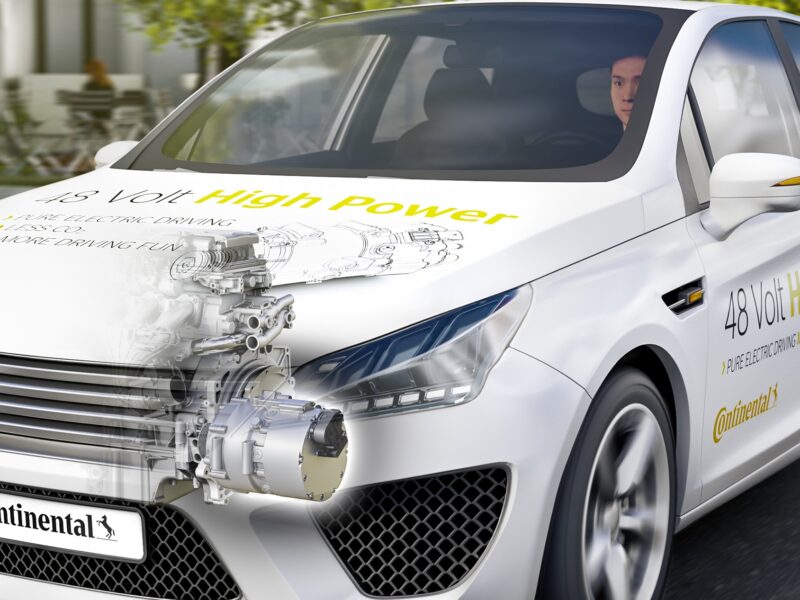
Continental enables full hybrid vehicles with 48V
A full hybrid vehicle with 48V technology – previously this was not considered feasible. If a hybrid vehicle can also drive purely electrically, the electrical part of the drive usually uses high-voltage technology, i.e. high voltages of up to 800V. Continental has now succeeded in developing a 48V hybrid system with comparable features to a high-voltage electric drive: 48V High-Power technology.
The 48V High-Power system comprises the electric motor with integrated power electronics and battery. According to Continental, it reduces fuel consumption and thus CO2 emissions by around 20%, compared with comparable vehicles with internal combustion engines. At the same time, the new 48V technology is significantly more cost-effective than the high-voltage systems used to date. “Our development goal was to use 48V technology to achieve a driving efficiency previously reserved for high-voltage systems. We have now achieved this,” says Stephan Rebhan, Head of Technology & Innovation Powertrain.
Previously, 48V systems were known as mild or so-called P0 hybrids. Fuel consumption is reduced primarily by supporting the combustion engine during acceleration (boosting) and by recovering excess kinetic energy during vehicle deceleration (recuperating). However, purely electric driving is not possible with such systems. In more recent development stages, the position of the 48V system in the powertrain has been modified. The electric motor was no longer positioned in front of the combustion engine on the crankshaft, but behind it – between the combustion engine and the transmission (P2 hybrid). The effect: fuel savings could be increased and in certain situations, such as driving through a 30 km/h zone, only the electric motor could move the vehicle across very limited distances.
With Contiental’s 48V High-Power technology, this hybrid system now offers the same functionality as previous full hybrid vehicles. The key component here is a new, water-cooled electric motor with a high degree of efficiency whose peak output has been doubled to 30 kW compared to the previous system. This makes it possible to drive purely electrically up to a speed range of 80 to 90 km/h.
The developers succeeded in doubling the power while retaining the diameter of the electric motor. Overall, the installation space required by the 48V High-Power Technology is only slightly larger than that of the previous system. The weight also changed only minimally.

Continental’s new 48V High Power traction motor.
However, the electric motor is not the only new component in the 48V High-Power technology. The integrated power electronics also work with a new technology that now allows significantly higher currents to be processed. The innovations of the new 48V High-Power technology lead to an electrical efficiency that exceeds that of the previous system by almost 10 %. And for recuperation, the new technology is much more effective than before, as the losses incurred have been halved.
The 48V High-Power technology thus offers all the advantages of a conventional full hybrid vehicle with a high-voltage system, i.e. optimised driving efficiency with lower fuel consumption and CO2 emissions. In addition, there is another argument in favor of Continental’s new hybrid solution: the comparatively low costs – which enable OEMs to develop low-cost hybrid vehicles and achieve a high level of market penetration. The reason: A 48V system requires considerably less insulation protection effort than a comparable vehicle with high-voltage technology; in addition, the electrical components are more compact and less expensive. The design can also be much more compact because the spacing between the individual components can be smaller than is necessary with high-voltage technology.
Continental is demonstrating the new 48V High-Power technology in a Ford Focus test vehicle. “With the new hybrid system, we are bringing out what is currently technologically possible in a 48V system,” says Stephan Rebhan. The technology is ready for series production.
In view of the new WLTP cycle approval regulations that have been in force in Germany and other countries since September 1, 2018, a further step in the development of 48V High-Power technology could be taken: If the system is supplemented by on-board charging technology and a larger battery, even a plug-in hybrid drive with 48V technology would be possible. Because in order to benefit from state subsidies for plug-in vehicles, the central criterion is not the ability to drive purely electrically, but generally the conversion of electrically stored energy into traction. The decisive factor for various support measures is whether CO2 emissions can be reduced below 50 g per kilometre.
Related articles:
Dual-voltage battery management system enables mild hybridization
Former Saab factory to produce Sion electric vehicle
Hella introduces electromobility strategy
48V demo vehicle highlights potential of mild hybrid
 If you enjoyed this article, you will like the following ones: don't miss them by subscribing to :
eeNews on Google News
If you enjoyed this article, you will like the following ones: don't miss them by subscribing to :
eeNews on Google News




